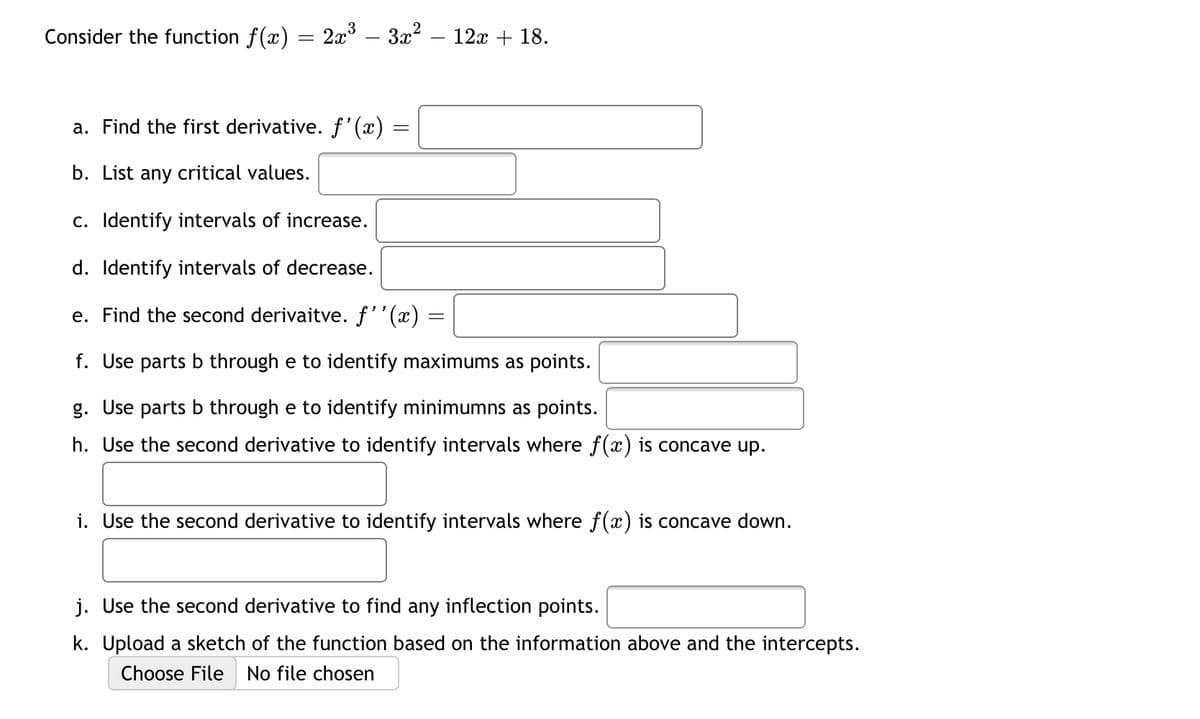Consider the function f(x) = 2x – 3x2 – 12x + 18. a. Find the first derivative. f'(x) = b. List any critical values. c. Identify intervals of increase. d. Identify intervals of decrease. e. Find the second derivaitve. f''(x) = f. Use parts b through e to identify maximums as points. g. Use parts b through e to identify minimumns as points. h. Use the second derivative to identify intervals where f(x) is concave up. i. Use the second derivative to identify intervals where f(x) is concave down. j. Use the second derivative to find any inflection points. k. Upload a sketch of the function based on the information above and the intercepts. Choose File No file chosen
Consider the function f(x) = 2x – 3x2 – 12x + 18. a. Find the first derivative. f'(x) = b. List any critical values. c. Identify intervals of increase. d. Identify intervals of decrease. e. Find the second derivaitve. f''(x) = f. Use parts b through e to identify maximums as points. g. Use parts b through e to identify minimumns as points. h. Use the second derivative to identify intervals where f(x) is concave up. i. Use the second derivative to identify intervals where f(x) is concave down. j. Use the second derivative to find any inflection points. k. Upload a sketch of the function based on the information above and the intercepts. Choose File No file chosen
Functions and Change: A Modeling Approach to College Algebra (MindTap Course List)
6th Edition
ISBN:9781337111348
Author:Bruce Crauder, Benny Evans, Alan Noell
Publisher:Bruce Crauder, Benny Evans, Alan Noell
Chapter2: Graphical And Tabular Analysis
Section2.1: Tables And Trends
Problem 1TU: If a coffee filter is dropped, its velocity after t seconds is given by v(t)=4(10.0003t) feet per...
Related questions
Question

Transcribed Image Text:Consider the function f(x) = 2x° – 3x? – 12x + 18.
a. Find the first derivative. f'(x) =
b. List any critical values.
c. Identify intervals of increase.
d. Identify intervals of decrease.
e. Find the second derivaitve. f''(x)
f. Use parts b through e to identify maximums as points.
g. Use parts b through e to identify minimumns as points.
h. Use the second derivative to identify intervals where f(x) is concave up.
i. Use the second derivative to identify intervals where f(x) is concave down.
j. Use the second derivative to find any inflection points.
k. Upload a sketch of the function based on the information above and the intercepts.
Choose File
No file chosen
Expert Solution
This question has been solved!
Explore an expertly crafted, step-by-step solution for a thorough understanding of key concepts.
Step by step
Solved in 2 steps with 2 images

Recommended textbooks for you

Functions and Change: A Modeling Approach to Coll…
Algebra
ISBN:
9781337111348
Author:
Bruce Crauder, Benny Evans, Alan Noell
Publisher:
Cengage Learning

Functions and Change: A Modeling Approach to Coll…
Algebra
ISBN:
9781337111348
Author:
Bruce Crauder, Benny Evans, Alan Noell
Publisher:
Cengage Learning